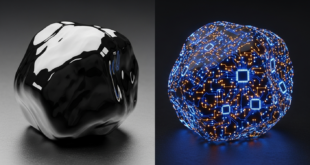“Invisibility” is a goal that has been long sought after by the Militaries. An operational cloaking chip could be an extension of technologies such as radar-absorbing dark paint used on stealth aircraft, local optical camouflage, surface cooling to minimize electromagnetic IR emissions, or electromagnetic wave scattering. Metamaterials are the primary materials that are for cloaking, making their platforms, weapons and persons invisible from electro-optic sensors, radars and sonars.
Metamaterials are artificially structured materials designed to control and manipulate physical phenomena such as light and other electromagnetic waves, sound waves and seismic waves in unconventional ways, resulting in exotic behavior that’s not found in nature. They are predicted to be able to protect the building from earthquakes by bending seismic waves around it. Similarly, tsunami waves could be bent around towns, and sound waves could be bent around a room to make it soundproof.
Currently, the military is also backing the creation of a “Quantum Stealth” camouflage material that makes its wearers completely invisible to the naked eye by bending light waves around them. A Canadian company is spearheading that effort, which is, like Quantum Stealth itself, shrouded in secrecy. Israeli researchers are also working on a “cloaking carpet” that uses a similar light-deflecting technology.
NATO troops will soon become invisible to radar and thermal cameras thanks to a groundbreaking fabric developed in Turkey, said officials. The fabric, which has reportedly passed tests by the Turkish Armed Forces, spreads a person’s body heat to confuse thermal cameras. It also makes it easier for soldiers to hide from night vision scopes and other detectors. A team of researchers at Moscow’s National University of Science and Technology (NUST MISIS) have come up with a unique metamaterial which can make combat vehicles invisible, the authoritative scientific journal Physical Review wrote.
But an invisibility cloak needn’t be a sinister tool of war. Vanderbilt’s Valentine suggests architectural usage. “You could use this technology to hide supporting columns from sight, making a space feel completely open,” he said. Other potential uses include rendering parts of an aircraft invisible for pilots to see below the cockpit, or to rid drivers of the blind spot in a car. Toyota has recently patented a cloaking device designed to turn vehicles’ A-pillars to the left and right of the car’s dashboard invisible, improving road visibility for the driver.
Optical or Invisibility Cloaks
“The idea behind metamaterials is to mimic the way atoms interact with light, but with artificial structures much smaller than the wavelength of light itself,” said Boris Kuhlmey from the University of Sydney. This way, their properties are derived from both the inherent properties from their base materials as well as the way they are assembled, such as the design of their shape, geometry, size, orientation and arrangement. Thus optical properties are no longer restricted to those of the constituent materials, and can be designed almost arbitrarily. Metamaterial-enabled devices have a wide range of applications in the RF, THz, IR, and visible spectrum.
Different Metamaterials and methods are being tried for cloaking. Metamaterial cloaking is used to building devices that can hide something, so that a defined region of space is invisibly isolated from passing electromagnetic fields (or sound waves). Researchers from the Max Planck Institute are working on mimicking the biology of moths’ eyes to turn lenses and glass invisible. Meanwhile, a group from the University of California, San Diego is controlling how light reflects on objects using a thin “carpet cloak” made form Teflon and ceramic particle.
Using a metasurface and an integrated photonics platform, researchers have conceived a method of achieving invisibility cloaks by tailoring evanescent fields. The approach deflects and scatters light away from a ‘cloaking’ chip surface so it is not detected. The scattering fields of the object located on the cloak do not interact with the evanescent field, rendering the object invisible.
To design a plasmonic waveguide-based invisibility cloaking scheme, Ben-Gurion University of the Negev (BGU) researchers performed an analysis of the modal distribution and surface intensity in a channel photonic waveguide with a metasurface overlayer. The spatial distribution of the metasurface permittivity was analytically calculated based on transformation optics principles. The spatial distribution was then imported into a commercial Maxwell solver using the finite-difference time-domain method (FDTD).
Researchers demonstrated cloaking for a cylindrical object with diameter of 70 percent from the waveguide width on a high index ridge waveguide structure with a silicon nitride guiding layer on silica substrate. “We showed that it is possible to bend the light around an object located on the cloak on an optical chip. The light does not interact with the object, thus resulting in the object’s invisibility,” said Alina Karabchevsky, head of BGU’s Light-on-a-Chip Group.
“These results open the door to new integrated photonic devices, harnessing electromagnetic fields of light at nanoscale for a variety of applications from on-chip optical devices to all-optical processing,” Karabchevsky said. The researchers’ next step will be to develop a prototype.
3D invisibility “skin” cloak at Berkley
Berkeley researchers have devised an ultra-thin invisibility “skin” cloak that can conform to the shape of an object and hide it from detection with visible light. Although this cloak is only microscopic in size, the principles behind the technology should enable it to be scaled-up to conceal macroscopic items as well.
They demonstrated a metasurface cloak made from an ultrathin 80 nanometers thick layer of gold nanoantennas that was wrapped around a three-dimensional object about the size of a few biological cells and arbitrarily shaped with multiple bumps and dents. The surface of the skin cloak was meta-engineered to reroute reflected light waves so that the object was rendered invisible to optical detection when the cloak is activated.
When the cloak is turned “on,” the bump-shaped object being illuminated in the center white spot disappears from view. The object reappears when the cloak is turned “off.” This is the first time a 3D object of arbitrary shape has been cloaked from visible light.
Invisibility in diffusive light scattering media
In 2014, scientists demonstrated good cloaking performance in murky water, demonstrating that an object shrouded in fog can disappear completely when appropriately coated with metamaterial. This is due to the random scattering of light, such as that which occurs in clouds, fog, milk, frosted glass, etc., combined with the properties of the metatmaterial coating. When light is diffused, a thin coat of metamaterial around an object can make it essentially invisible under a range of lighting conditions.
Turkey-made invisible fabric to sell to NATO countries
A Turkey-made invisible fabric that cannot be spotted by radars and thermal cameras will soon be sold to NATO countries. The fabric, developed at the Sun Textile and Research Development Center, succeeded tests by the Turkish Armed Forces, and is now awaiting approval from Turkey’s Defense Ministry for export.
Sabri Ünlütürk, chairman of the executive board of Sun Holding, told state-run Anadolu Agency on Nov. 16 that the fabric was invented by two scientists at Teknokent of Hacettepe University in Ankara. He added that they began producing the fabric in their factory in the western province of İzmir, and came third after the U.S. and Israel in this particular technology.
“We are proud that the Turkish army is using this fabric. The previous products were only for visual camouflage,” Ünlütürk added. He said the fabric spreads body heat in a way that makes the person wearing it impossible to be spotted by thermal cameras. The tests for the camouflage uniforms are currently underway. “These uniforms are designed for our soldiers to hide themselves from night vision scopes. Military units are testing them,” Ünlütürk said.
Toyota Patents a “Cloaking Device”
Toyota is developing a device that would allow objects to turn invisible, or at least transparent. The Japanese car maker recently received a patent from the U.S. Patent and Trademark Office for a device meant to improve the visibility of drivers.
According to Toyota, such a technology is already possible — like the Rochester Cloak — but it would require video cameras and other expensive equipment for it to work in cars. This cloaking device, on the other hand, would be a less expensive solution. It would use mirrors to bend visible light around the A-pillars to allow the driver to “see” through them. This would give drivers a wider view of the road and their surroundings. It also benefits pedestrians, as drivers would see them better.
“Light from an object on an object-side of the cloaking device [i.e., facing the road] is directed around an article [the A-pillars] ]within the cloaking region and forms an image on an image-side of the cloaking device [i.e., facing the driver’s seat] such the article appears transparent to an observer looking towards the object,” according to a description of the device in the patent.
References and Resources also include:
http://www.newsweek.com/nato-military-defense-turkey-technology-invisible-fabric-717050
http://www.newsweek.com/nato-military-defense-turkey-technology-invisible-fabric-717050
https://www.photonics.com/a62847/Researchers_Manipulate_Light_to_Make_Optical_Chip
 International Defense Security & Technology Your trusted Source for News, Research and Analysis
International Defense Security & Technology Your trusted Source for News, Research and Analysis



